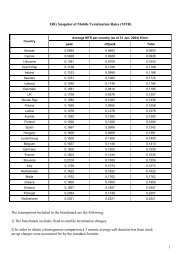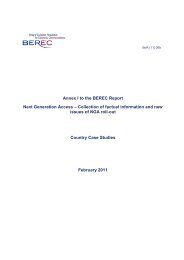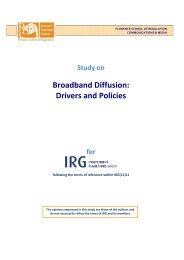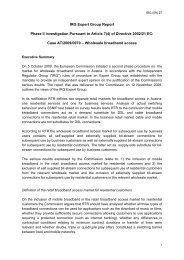You also want an ePaper? Increase the reach of your titles
YUMPU automatically turns print PDFs into web optimized ePapers that Google loves.
4. Estimating the Cost of Equity under CAPM<br />
4.1 The cost of equity<br />
<strong>IRG</strong>-WG RA (<str<strong>on</strong>g>07</str<strong>on</strong>g>) <strong>WACC</strong> Master Doc<br />
As illustrated in the previous chapter, the cost of equity reflects the return <strong>on</strong> equities<br />
(through dividends and through an increase in the value of shares) that is required to attract<br />
investors.<br />
Despite its limitati<strong>on</strong>s, the CAPM approach is the methodology widely used by finance<br />
practiti<strong>on</strong>ers and regulators for determining the cost of equity. The cost of equity is a<br />
necessary input for the <strong>WACC</strong> calculati<strong>on</strong>. The CAPM has a clear theoretical foundati<strong>on</strong> and<br />
its implementati<strong>on</strong> is relatively simple. It asserts that the required rate of return <strong>on</strong> a risky<br />
asset is a functi<strong>on</strong> of the risk free rate of return (Rf) plus a risk premium that reflects the<br />
return <strong>on</strong> a well-diversified portfolio of risky assets over the risk free rate (Rm – Rf), scaled by<br />
the “beta” of the risky asset 6 :<br />
E(Rj) = Rf + βj [E (Rm) - Rf]<br />
PIB 5:<br />
<strong>IRG</strong> acknowledges that the use of CAPM as a method to estimate the cost of equity is<br />
supported by its relatively simple implementati<strong>on</strong> and by its wide use am<strong>on</strong>g<br />
regulators and practiti<strong>on</strong>ers.<br />
4.2 The risk free rate<br />
The risk free rate is the expected return <strong>on</strong> an asset, which bears in theory no risk at all 7 , i.e.<br />
whose expected returns are certain. In practice, it is not possible to find an investment that is<br />
free of all risks. However, freely traded investment-grade government b<strong>on</strong>ds can generally<br />
be regarded as having close to zero default risk and zero liquidity risk.<br />
When defining the risk free rate, the relevant market has to be chosen 8 . The relevant market<br />
for the definiti<strong>on</strong> of the risk free rate, may be c<strong>on</strong>fined to the domestic market, although other<br />
country’s government b<strong>on</strong>ds can also be used as a proxy for the risk free rate. The choice of<br />
6<br />
The principle of CAPM is that there is a direct relati<strong>on</strong>ship between the price of an asset and its<br />
return and risk. The risks borne by an investor can be divided into company specific (diversifiable) risk<br />
and systematic (n<strong>on</strong>-diversifiable) market risk. This model is based <strong>on</strong> the theory that the required<br />
return <strong>on</strong> an asset is related to its systematic risk, that is, the degree of co-movement between the<br />
company's returns and the market returns, given that specific risk can be diversifiable by holding a<br />
broad portfolio of assets. Therefore, CAPM calculates the return required by investors for accepting<br />
the (systematic) risk associated with a specific company, by reference to the volatility of returns <strong>on</strong> the<br />
particular company relative to those of the market portfolio as a whole.<br />
7<br />
For an investment to be risk free, two c<strong>on</strong>diti<strong>on</strong>s have to be met: there can not be any default risk<br />
which usually implies that the security has to be issued by a government; there can be no uncertainty<br />
about reinvestment rates, which implies that there are no intermediate cash flows, as with zero coup<strong>on</strong><br />
b<strong>on</strong>ds.<br />
8<br />
First, the cost of capital should be estimated with reference to the financial market that best<br />
represents the company's investment opportunity set. However, this will depend up<strong>on</strong> matters such as<br />
exchange rate risk, taxati<strong>on</strong> barriers, transacti<strong>on</strong> costs of transferring capital between markets and<br />
capital c<strong>on</strong>trols.<br />
14







